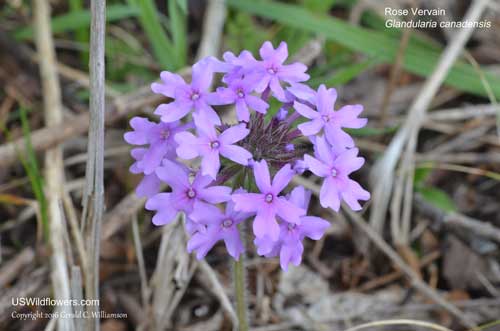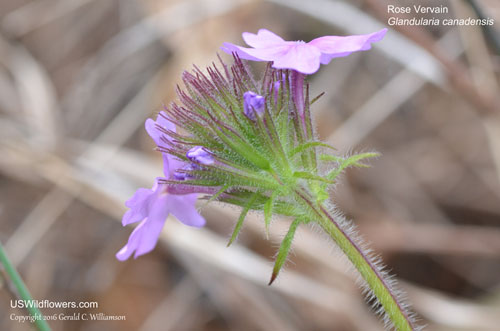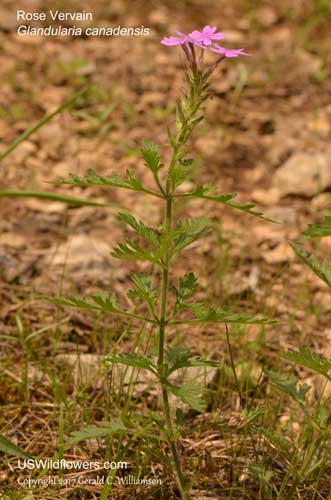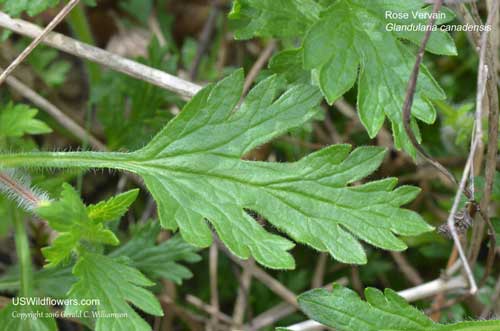Rose Vervain, Rose Mock Vervain, Rose Verbena, Sweet William, Clump Verbena - Glandularia canadensis
|
Glandularia canadensis - Rose Vervain, Rose Mock Vervain, Rose Verbena, Sweet William, Clump Verbena. Glandularia is a genus of around 100 species of the Western Hemisphere, with around 20 found in the United States, about 15 or so of those species being native (the genus is still developing as further study of the Verbeneae tribe Verbenaceae is done.) Most of those species are found west of the Mississippi River, centered primarily around Texas and New Mexico. Glandularia is closely related to Verbena, with the most reliable diagnostic between the species now being the length of the styles relative to the length of the ovary, with Glandularia being longer. With the longer styles, the corolla of Glandularia is more likely be be salverform (corolla tube narrow from the base and then abruptly flaring into a mostly flattened array of corolla lobes) whereas that of Verbena, with the shorter styles, is funnelform (corolla gradually widening from the base in a funnel shape.)
Glandularia canadensis was classified as Verbena canadensis until recent rework in Verbenaceae placed it into Glandularia. It is the most widely distributed member of the genus in the United States, being found in most states east of the Rockies, although it is introduced rather than native in much of its more northern area of distribution. I find the species epithet interesting since it is not found in Canada. Glandularia bipinnatifida is the next most widely distributed species, with much range overlap with Glandularia canadensis.
Found in:
AL, AR, CO, CT, FL, GA, IA, IL, IN, KS, KY, LA, MI, MN, MO, MS, NC, NE, NM, NY, OH, OK, PA, SC, TN, TX, VA, WI, WV
Leave comments on Glandularia canadensis at this link. | 
Distribution of Glandularia canadensis in the United States and Canada:

Blue=Native; Grey=Introduced
Map from USDA Plants Database:
USDA, NRCS. 2017. The PLANTS Database (http://plants.usda.gov, 08 May 2025). National Plant Data Team, Greensboro, NC 27401-4901 USA.
Search Our Database: Enter any portion of the Scientific, Common Name, or both.
Do a general Google search of the entire site:
#ad
 Follow USWildflowers on Twitter
#ad
| | Site: Couchville Cedar Glade, Davidson County, TN Date: 2016-March-30 | Photographer: Gerald C Williamson
Nikon D7000 | | The flowers of Rose Vervain are rosy purple, bluish, or white with notches at the end of the five corolla lobes. The lobes are usually somewhat unequal in size The flowers are up to about .6 inch across. The calyx lobes are 7 to 13 mm long, and very hairy with stalked glandular hairs. | | 
| | Site: Couchville Cedar Glade, Davidson County, TN Date: 2016-March-30 | Photographer: Gerald C. Williamson
Nikon D7000
Tamron SP 90MM f/2.8 AF Macro | | The inflorescence of Glandularia canadensis is a terminal spike that is usually somewhat rounded at initial inflorescence, elongating as it begins to develop seeds. | | Click on the photo for a larger image

| | Site: Couchville Cedar Glade, Davidson County, TN Date: 2016-March-30 | Photographer: Gerald C Williamson
Nikon D7000 | | The calyx lobes of Glandularia canadensis are 7 to 13 mm long, and very hairy with stalked glandular hairs. Those of Glandularia bipinnatifida (Dakota Vervain), which has much range overlap with G. canadensis, are hairy but usually non-glandular, or if glandular only sparsely so (assuming more recent classification changes are accepted.) The inflorescence bracts are shorter than the calyx lobes in G. canadensis; in G. bipinnatifida the bracts may be longer than the calyx. In both the bracts are hairy, and may or may not include glandular hairs. | | Click on the photo for a larger image

| | Site: Couchville Cedar Glade, Davidson County, TN Date: 2017-May-11 | Photographer: Gerald C Williamson
Nikon D7000 | | Rose Vervain is usually 12 to 24 inches tall with opposite leaves. The stem is hairy, and may be erect or sprawling. The flowers are salviform - the narrow corolla tube flares suddenly to the flat top of 5 lobes. | | Click on the photo for a larger image

| | Site: Couchville Cedar Glade, Davidson County, TN Date: 2016-March-30 | Photographer: Gerald C Williamson
Nikon D7000 | | The somewhat hairy leaves of Glandularia canadensis are 1 to 3 inches long and are pinnately lobed. The leaves of Glandularia bipinnatifida are more finely dissected. | | Click on the photo for a larger image

|
References used for identification and information:
- Weakley's Flora of the Southern and Mid-Atlantic States (2015)
- Wildflowers of Tennessee, the Ohio Valley and the Southern Appalachians: 2nd Edition
- Flora of Virginia Project, Alan S. Weakley, J. Christopher Ludwig, John F. Townsend, Bland Crowder, 2012 and forward
- Vascular Plants of the Gila Wilderness Presented in Association with the Western New Mexico University Department of Natural Sciences
- Evolution of morphological traits in Verbenaceae, Nataly O'Leary, Carolina Isabel Calvino, Susana Martinez, Pat Lu-Irving, Richard G. Olmstead, Maria Ema Mulgura, from the American Journal of Botany
- TAXONOMY OF THE GLANDULARIA BIPINNATIFIDA GROUP (VERBENACEAE) IN THE USA by GUY L. NESOM
|
|
| |
| #ad
|
|







